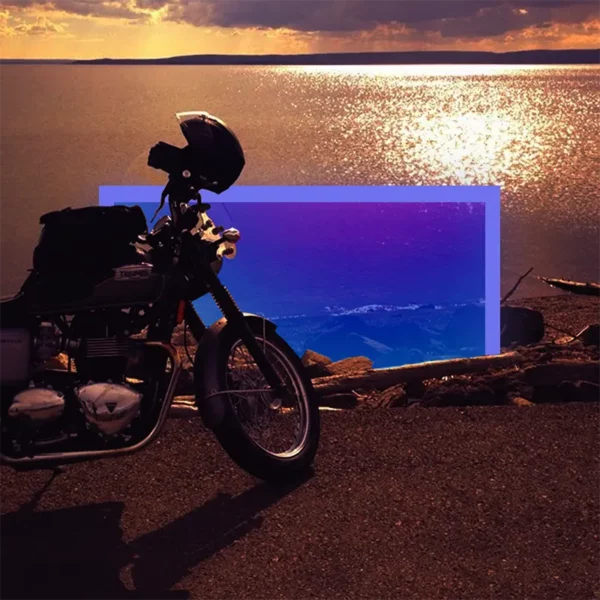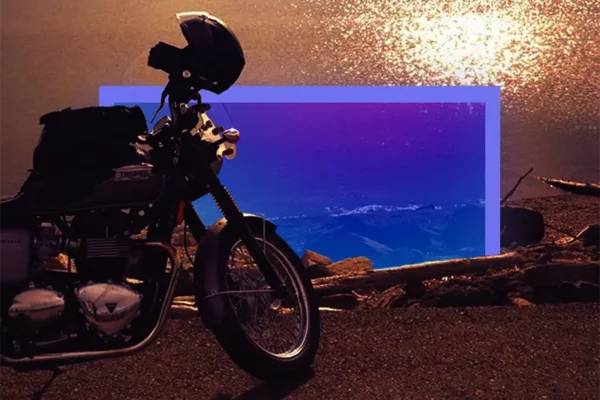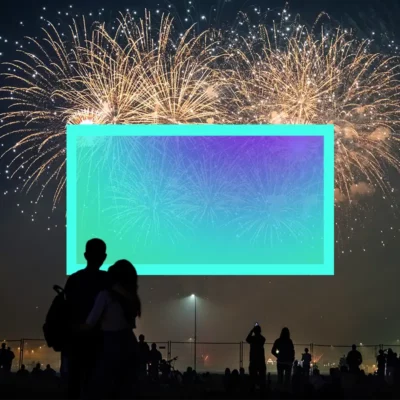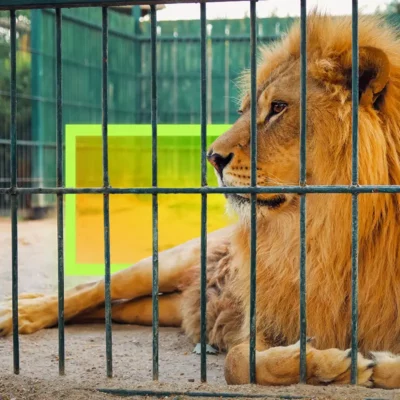Hitting the open road to find my way home
Host of NPR’s Wait, Wait…Don’t Tell Me!, Peter Sagal is wrecked and stuck in the wake of a divorce. Suddenly, he finds himself with two free weeks. In need of a healthy distraction, Peter jumps on his Harley for a long solo trip out west. Though he has a destination in mind, what he finds on those quiet, desolate, curvy roads is a new focus, a new voice. And though his aim was to fill his time, he begins to appreciate the quiet – where he can actually hear himself. Photo credit: Thaib Wahab.


Table of Contents:
Transcript:
Hitting the open road to find my way home
PETER SAGAL: And yet, with all the necessity of paying perfect attention to what I’m doing, or maybe because of that, my thoughts still flow, in a more coherent way than they have in a while. My mind is also able to roam backwards and forwards over my life, past, present, and future. I think of my kids and what will happen to them. I remember a hundred moments from our lives together, a life which either has profoundly changed or perhaps even ended. I think of being alone in this moment – gloriously, completely, alone, my mind protected by a full-face helmet, enclosing myself with myself – and how long that solitude will last, and how long I might want it to.
ROHAN GUNATILLAKE: Have you ever been on a motorbike? The freedom, the space, being so connected to both machine and nature at the same time.
Peter Sagal is a long-time biker and host of NPR’s “Wait Wait, Don’t Tell Me!”. Today, he shares a Meditative Story about a trip through the American Midwest which gave him the space that he needed – inside and out – to navigate a difficult time in his life.
In this series, we blend immersive, first-person stories with mindfulness prompts to help you restore yourself at any time of the day. I’m Rohan, and I’ll be your guide on this episode of Meditative Story. From time to time, we’ll pause the story ever so briefly for me to come in with guidance for a deeper connection to the story.
The body relaxed. The body breathing. Your senses open. Your mind open. Meeting the world.
SAGAL: It is the summer of 2013. My marriage has recently broken up, and my hopes for an amicable, non-confrontational, and inexpensive split have been dashed like a watermelon falling from a great height.
My soon-to-be ex-wife is taking the kids away for a trip, with myself pointedly not invited, and so I have two weeks off from work with nothing to occupy myself, and that in and of itself is a danger. Without anything I need to do, I tend to distract myself in a variety of unhealthy ways. With so much trouble swirling around, I know myself enough to know that I will do anything to avoid thinking about it. I’ll stare at the internet or TV screens or seek any other kind of distraction in order to not give myself a moment to confront what I’m facing.
I look around for something to focus on. I see that the annual motorcycle rally in Sturgis, South Dakota, is happening right in the middle of my break. It’s a legendary event, attended by more than a 100,000 riders every year. Why not one more?
There is no quieter place I know than the saddle of a motorcycle. Motorcycles themselves, of course, can be loud, although they’re not supposed to be as loud as the ones who pull up next to you at a stoplight and pierce your glass shell with their insecure roaring.
A modern stock motorcycle, though, with its electronically controlled four stroke engine and street legal mufflers – like my 2013 Triumph Bonneville T-100 – sounds almost as polite as a family sedan. Riding it, the exhaust notes are hard to hear over the wind blowing past my helmet. All of this is why, in August of 2013, I pack some clothes into saddlebags, get on my Triumph in Chicago, and head west. I need some peace and quiet to think.
GUNATILLAKE: How about you? Are you going through anything right now which makes you want some peace and quiet to be still and reflect? If you do, then acknowledge that wish and take the next few moments to set the intention to gift yourself that time.
SAGAL: I get a late start on the first day. I strap my bags to the seat behind me, put on my boots, helmet, and riding jacket, throw my leg over the bike, start the engine, and head off down the alley to the street. I feel protected, covered in leather, rip stop nylon, and a puncture proof casing for my head, but at the same time, of course, I’m extraordinarily vulnerable. This is how I’m going to travel for the next two weeks: excepting stops to sleep and eat, I’ll spend every moment directly beneath the open sky.
To make up for my late start I hop onto the freeway to log some miles before dark. I quickly learn why I shouldn’t do this trip on freeways. On a motorcycle, you have none of the standard distractions from freeway monotony available in a car: no radio, no audiobooks, no phone calls, not even an open bag of snacks to dip into.
At the same time, the riding itself is boring to the point of danger. You put the bike in the highest gear, you twist back the throttle, and spend hours with nothing to do but try to avoid hitting a piece of road debris or getting too close to the windy maelstrom every trailer truck creates in its wake. It seems unbelievable that being in constant danger of instant death can be dull, but it’s true. After that wearying first day, I am determined to make the rest of the trip on secondary roads.
Riding a motorcycle requires your entire mind and body. Your right hand controls the throttle and front brake. The fingers of your left hand pull on a lever that engages the clutch. Your right foot presses on the rear brake, and the left foot operates the gear shift, pressing down or pulling up, by slipping the toe of your boot under the metal lever. Meanwhile, you lean into turns, shift your weight backward slightly when you brake, lower yourself behind the windshield when you speed up. For a practiced rider, all of these actions are unconscious but still demand your focused attention.
But not all of it. Motorcycling is inherently dangerous, of course, and not just because something that might be an annoyance in a car is potentially fatal on a motorcycle. It’s also because even if you’re as careful as possible, whatever the opposite of reckless is – reckful? – you’re also vulnerable to other people’s mistakes.
So we motorcyclists practice a discipline often called “total awareness.” You scan the road surface ahead, looking for debris or potholes, then the cross streets, checking for cars about to pull in front of you. If there’s a car in the lane beside you, you anticipate it suddenly switching lanes right into yours. You play out scenarios, first the disaster, then the complicated combination of twists, squeezes, and leans that will allow you, with luck, to avoid it.
This is an extraordinary contrast to my daily life. Like most people, I’m rarely in any physical danger, or even exposed to the elements. I can then indulge, like so many of us do, in the luxury of obliviousness. I don’t notice what’s around me, because it can’t hurt me. I don’t think about the next corner because whatever’s around it will probably be the same as what’s on this side. So I am free to focus on… nothing. Distractions. Trivia. Why not? Nothing’s going to happen to me if I do.
On the straight roads of the Great Plains west of Chicago, I’m alone more often than I’m dealing with traffic, and intersections are few and far between. So I monitor the road, upshift and downshift as needed, and I’m able, finally, to take in the world. You don’t know how isolated you are in a car until you ride the same road without the steel and glass cocoon.
I see a thousand things along the roadside I never would have noticed – the varying heights of the corn fields on different farms, the peeling paint on the billboards in far too remote a location to be worth anyone covering up their past, and maybe last, paying advertisers. The lines of trees in the distance that I eventually figure out mark streams and canals. The businesses and homes and occasional weird interruptions of the common visual fabric – a fence festooned with bras, a water tower painted like a hot air balloon.
It’s on a trip to a place a thousand miles away that, for the first time in years, I start to notice exactly where I am – even as, with each moment of awareness, I speed away to another square of pavement.
I spend the night in Pierre, South Dakota, and then roll west, and I find myself in fields of sunflowers, spreading to the horizon on both sides. I pull over, remove my helmet, and walk out a few hundred yards into the rows of flowers. I stand there for a long while, looking in the same direction the flowers are looking, towards the morning sun. Bees buzz. Every now and then a car passes, and I bet the drivers are too distracted by whatever they’ve chosen to distract themselves with to notice the odd flower standing out in the middle of all the others.
GUNATILLAKE: Imagine being there with Peter, alongside him. As you do, what details can you notice? What color are the flowers? Can you even catch their scent? Take three deep, full breaths and settle back into the scenery.
SAGAL: Sturgis itself is kind of bust, at least for me. A hundred thousand people who’ve chosen to rebel by dressing, drinking, and partying exactly alike. Even with all the lights shining down, there’s nothing to see, and even with all the amusements on offer – mostly involving liquor and scantily clad women – there’s nothing to hold my attention. After one day, I roll on to take in something more interesting, meaning, nothing at all.
The hills rise beyond Sturgis, and now I’m doing a different kind of riding. Where once I was constantly monitoring the road and my place on it, now the pavement becomes more active, so I do too. It rises and turns to the left, so I brake, downshift and position myself on the right side of the road. Then I lean into a smooth curve and exit the turn on the correct trajectory, smoothly accelerating which straightens the bike out, while I immediately plan for the next turn.
With a few exceptions, there is nothing in modern life that requires absolutely all of our attention. Farmers sit in tractor cabs listening to the radio while the GPS systems make sure they plow in exact straight lines. Even airline pilots spend most of the flight amusing themselves while a computer flies the plane.
Eventually, I get to the Rockies. I ascend up the Lolo Pass west of Missoula, Montana, get to the peak at about 4 pm, and then start descending Route 12 into Idaho, following the path of Lewis and Clark, who had worked their way west, two centuries before, on the Crooked Fork river, in a ravine below this highway. For a city dweller, it’s a bit disorienting to look at a line of trees next to the road and realize that behind those trees are more trees, and more trees, that they are not the exception to the rule of this landscape. I am.
There is nothing but forest between me and Idaho, 50 miles or so ahead, and I’m on a twisty mountain road with sunset just a few hours away. I don’t want to get caught trying to navigate the twists and turns only by headlight, so I need to make good time in order to find a place to sleep before dark.
The danger is real, especially as it seems nobody else is dumb enough to attempt the descent this close to dark. If I crash, it might be hours before somebody comes along to find me. If I go over the side of the road, and into the ravine next to it, it might be days, or longer. After all, nobody has any idea where I am.
And yet, with all the necessity of paying perfect attention to what I’m doing, or maybe because of that, my thoughts still flow, in a more coherent way than they have in a while. My mind is also able to roam backwards and forwards over my life, past, present and future. I think of my kids and what will happen to them. I remember a hundred moments from our lives together, a life which either has profoundly changed or perhaps even ended. I think of being alone in this moment – gloriously, completely alone, my mind protected by a full-face helmet, enclosing myself with myself – and how long this solitude will last, and how long I might want it to.
Without a phone, without radio, without music, without food or drink, without anything but myself and this machine, I’m more alive, more aware than I‘ve been in years, or decades. Psychologists say that trauma imprints most vividly on our memory, and I imagine that has to do with the fact that potential threats trigger our survival instincts – our awareness heightens as we try to fend off or avoid whatever might harm us.
So maybe this rolling mindfulness I’m experiencing, my thoughts rolling free inside of my helmet like a marble, is merely a related epiphenomenon – by riding a motorcycle, and subjecting myself to constant danger as long as I’m moving, I trick my brain into a constant state of threat-response, a heightened awareness, fueled by adrenaline, but one that doesn’t trigger a fearful panic response, as long as I keep the rubber side down, anyway.
So as I navigate this beautiful road on an August evening, my mind and body working together without conscious thought, my attention roams to and fro in interior journeys that sometimes stray far from my physical one. This is my garden, my zen temple, my still, quiet room. And I’m averaging 50 miles an hour, downhill, on a mountain road with a cliff on one side and a ravine on the other.
I cross into Idaho around 6 pm, and just as I start to think I might need to turn my bright headlights on, I find a riverside motel, with one room left for the evening and a diner, which specializes in pie. I park the bike, shed the helmet, gloves, and jacket, and take my notebook to dinner, so I can write down all that I’ve experienced while I eat. As it turns out, after a day of silence and constant motion, I have a lot to say.
Rohan’s closing meditation
GUNATILLAKE: I really love the image that Peter draws out of him hurtling down and around mountain roads, totally present to that experience but at the same time his thoughts rolling just as free. So I think it might be fun to do something similar.
So if you’re up for that, begin by relaxing your shoulders, relaxing your face, breathing, smiling. Listening to this podcast, engaging with this short meditation practice in its own way is a little act of kindness to yourself. So why not appreciate that?
Eyes open or eyes closed, whatever feels most appropriate and most safe, notice your posture. It might be sitting down like Peter, or it might be in a different position. However it is, notice it. Inhabit it, if that makes sense.
And let’s be like Peter. He had his hands on the handlebars, connected to his bike. Where are your hands and what are they connected to? Drop your awareness, your attention into whatever sensations of touch and connection that exist in your hands right now. Whatever they’re in contact with, know it. Rest with those sensations.
Now include your feet. Sitting back, Peter had his on the footpegs of his bike. While still sensitive to your hands contacting whatever they’re contacting, also include your feet. Bringing the contact of your feet on the ground into your awareness. Knowing that contact, just as it is.
Your awareness, your attention resting and balanced with these four points, your hands, your feet.
Can you feel all of these four points at the same time? Make them the foundation of your awareness, your place of rest. If it helps, you can imagine Peter riding on his Triumph, doing the same. Even ride alongside him if you like. Always resting in your hands and feet. On your handlebars and footpegs, whatever they may be for you.
You may not have the wind rushing through your hair like Peter did, but what do you have? Notice the temperature of the air on your face. All the while keeping in touch with your hands and feet. Keeping in touch with your foundation.
Now, if you’ve drifted away, reconnect with your feet and your hands. Establish that foundation, stable and connected. And let your mind roam free. Let your thoughts roll around. Watching the thoughts and ideas dance on the screen of your mind. All the while stable and connected to your body, through your hands and your feet.
And to finish, see yourself in a bigger frame. Peter was just one little human moving through a landscape of endless trees and trees and trees. That view gave him perspective and space from his personal drama, which otherwise might have felt so constricting and overwhelming.
So zoom out and imagine yourself, see yourself where you are. Just one human in a landscape full of so much stuff that is not your drama, not your storyline. If there’s peace here, enjoy it.
And as Peter ended his day by writing up his experiences, why not do the same? Take a moment to review how that practice was for you, how the story made you feel. And if there’s any pie around, all the better.





